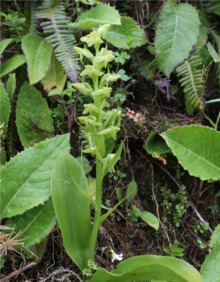Family Orchidaceae | Rank Species | |
 | ||
People also search for Platanthera micrantha, Agrostis azorica | ||
Platanthera azorica, commonly known as Hochstetter's butterfly orchid, is a species of orchid in the genus Platanthera. It was "rediscovered" in 2013 on a single volcanic ridge on the central Azores island of São Jorge, and "is arguably Europe's rarest bona fide orchid species." While P. azorica was previously considered by some sources to be the same as Platanthera micrantha, the 2013 discovery triggered a thorough analysis of historic and current data and specimens, resulting in three species identified.
Contents
Distribution
P. azorica is currently known to grow only in a single small upland area of São Jorge. Hochstetter's earlier expedition did not include São Jorge, so at least at one time it lived on another Azorean island.
Origin
Genetic testing confirms that the lineage of the species derives from Europe or North Africa, rather than North America as had been previously hypothesized, and evidence suggests "that the Azorean lineage represents a single migration of seed to the archipelago from a mainland European population..."
Description
There are now three distinct species of Azorean butterfly orchids:
Conservation status
The previously known P. micrantha was listed by the IUCN Red List of Threatened Species as Vulnerable, but that was under the assumption that all three Azorean butterfly orchids comprised a single species. Justification was given that the population is decreasing due to threats such as destruction of the habitat to create pastures, invasive plants and road construction.
The 2013 study that described the three distinct species stated that the prior Red List threat assessment be overturned because the species is Europe's rarest bona fide orchid species, and P. micrantha, an equally rare species, is a good indicator for the amount of semi-natural laurisilva habitats remaining on the Azores.
